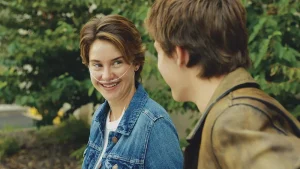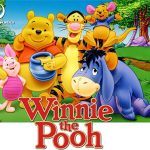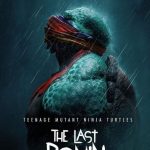“The Fault in Our Stars (2014)”

“The Fault in Our Stars” (2014) is a romantic drama film directed by Josh Boone, based on the bestselling novel of the same name by John Green. The film stars Shailene Woodley as Hazel Grace Lancaster, a sixteen-year-old cancer patient, and Ansel Elgort as Augustus “Gus” Waters, a charming and witty cancer survivor. The movie tells the poignant and heartbreaking story of their love affair, set against the backdrop of illness, personal growth, and the meaning of life.
Plot Summary
The story centers on Hazel Grace Lancaster, who has been living with terminal cancer for several years. She suffers from thyroid cancer that has spread to her lungs, leaving her dependent on an oxygen tank to help her breathe. Hazel’s life changes when she is encouraged to attend a weekly cancer support group, where she meets Augustus Waters, a charming, cancer-free, and optimistic young man. Gus, a former osteosarcoma patient, is drawn to Hazel, and the two begin a friendship that soon blossoms into a romantic relationship.
Despite their initial differences, the connection between Hazel and Gus grows as they bond over shared experiences, witty banter, and a mutual love of literature. Hazel’s favorite book is “An Imperial Affliction” by the reclusive author Peter Van Houten. After reading the book, Gus and Hazel bond over their questions about the story’s ending. Together, they embark on a trip to Amsterdam to meet Van Houten (played by Willem Dafoe) and get answers to the questions the book left unanswered. However, their journey does not go as expected, and they face the painful realities of life, love, and loss.
The movie explores the complexity of living with cancer, the dreams and aspirations of young people grappling with terminal illness, and the meaningful relationships formed along the way. Ultimately, the film reflects on how Hazel and Gus, despite the challenges of their conditions, find love, meaning, and peace in each other’s company.
Key Themes
- Love and Loss: The central theme of the film is the love story between Hazel and Gus, which is tender, heartwarming, and bittersweet. Their love, though short-lived, is profoundly impactful, as they learn to cherish every moment they have together. The film explores how even the most tragic and uncertain circumstances can give way to moments of true connection.
- Living with Cancer: The Fault in Our Stars doesn’t shy away from showing the harsh realities of living with terminal cancer. It depicts the physical and emotional toll of illness on both the patients and their families. Hazel and Gus’s struggles with their conditions are not romanticized but presented as part of their larger journey of coping with mortality and finding meaning in life.
- The Impact of Literature: Hazel and Gus’s love of literature is central to the story, particularly in their shared bond over “An Imperial Affliction”. The film illustrates the importance of stories in helping people understand themselves and the world around them. Books, especially the ones that challenge perceptions and reflect deep emotions, become a way for Hazel and Gus to articulate their feelings and make sense of their lives.
- Legacy and Meaning: The film also explores the idea of legacy, asking what it means to live a meaningful life. Gus, in particular, struggles with the idea of leaving a lasting impact on the world, while Hazel grapples with the realization that her life may be short and that she won’t leave a great mark on the world. In the end, they come to realize that love and the way they touch each other’s lives is enough to create a meaningful existence, regardless of how long it lasts.
- Coping with Grief: The movie also addresses the inevitable grief that comes with the loss of a loved one. Both Hazel and Gus understand the pain that comes with their condition, but they also try to live in the moment and appreciate their relationship, knowing the inevitable loss that will come. The film subtly delves into the ways people cope with grief and how love can help them face the reality of death.
Character Development and Performances
- Hazel Grace Lancaster (Shailene Woodley): Shailene Woodley’s performance as Hazel is powerful and nuanced. Hazel is intelligent, introspective, and often sarcastic, using humor as a coping mechanism for the overwhelming reality of her illness. Woodley brings depth and authenticity to the role, capturing Hazel’s vulnerability, resilience, and longing for a life that feels normal despite the cancer that defines so much of her existence.
- Augustus “Gus” Waters (Ansel Elgort): Ansel Elgort’s portrayal of Gus is charismatic, charming, and full of emotional depth. Gus is the opposite of Hazel in many ways—optimistic, outgoing, and full of hope. Elgort’s portrayal adds layers to Gus’s character, from his boyish confidence to the emotional maturity that emerges as he navigates his relationship with Hazel and confronts the realities of his condition.
- Isaac (Nat Wolff): Isaac, Gus’s best friend, provides both comedic relief and emotional depth to the film. Isaac’s own struggles with cancer and his relationship with Gus and Hazel add complexity to the film, showing the different ways cancer affects those around the patients. Wolff brings warmth and vulnerability to the role.
- Peter Van Houten (Willem Dafoe): Willem Dafoe plays the reclusive and enigmatic author Peter Van Houten, whose book deeply impacts Hazel and Gus. His character is complex, full of bitterness and grief, and he serves as a mirror to the emotional struggles faced by the protagonists. Dafoe’s performance adds depth to Van Houten, portraying both his brilliance and his emotional scars.

Cinematography and Direction
The film’s cinematography, led by Ben Richardson, is intimate and evocative. The use of close-ups captures the emotional intensity of the characters’ interactions, while wide shots of beautiful locations, like Amsterdam, contrast with the more confined spaces of the hospital rooms and Hazel’s home. The film’s pacing reflects the emotional beats of the story, balancing moments of humor with the heaviness of illness and loss.
Director Josh Boone captures the delicate tone of the book, balancing its themes of love and loss with the tender relationship between Hazel and Gus. The film’s direction allows the emotional depth of the story to resonate without ever feeling overly sentimental, creating a heartfelt and grounded experience for the audience.
Music and Soundtrack
The film’s soundtrack, curated by Marco Beltrami and featuring songs by Ed Sheeran, Birdy, Lorde, and Ray LaMontagne, complements the emotional tone of the film. The song “Boom Clap” by Charli XCX and Ed Sheeran’s “All of the Stars” became major hits, capturing the essence of the film’s blend of youthful love and poignant reflection on mortality.
The soundtrack’s songs are woven into the narrative seamlessly, helping to elevate the emotional moments and provide an extra layer of connection for the audience.
Reception and Legacy
The Fault in Our Stars was released to widespread critical acclaim, with particular praise for the performances of Shailene Woodley and Ansel Elgort, as well as the film’s ability to translate the emotional depth of the book to the screen. It became a major box office success, grossing over $307 million worldwide against a $12 million budget. It was also praised for its sensitive handling of difficult topics like cancer, love, and loss.
The film has become a cultural phenomenon, particularly among young audiences, and has inspired deep emotional reactions from viewers. It also contributed to the rise in popularity of young adult adaptations, solidifying its place as one of the most beloved films in the genre.
Cast and Crew
- Director: Josh Boone
- Writers: Scott Neustadter, Michael H. Weber (screenplay), based on the novel by John Green
- Cast:
- Shailene Woodley as Hazel Grace Lancaster
- Ansel Elgort as Augustus “Gus” Waters
- Nat Wolff as Isaac
- Willem Dafoe as Peter Van Houten
- Laura Dern as Frannie Lancaster
- Sam Trammell as Michael Lancaster

Fun Facts
- Real-Life Friendship: Shailene Woodley and Ansel Elgort’s real-life friendship made their on-screen chemistry even more authentic. They had known each other for years before the film and developed a deep bond during the production.
- The Book’s Popularity: The novel The Fault in Our Stars became a massive bestseller and was highly praised by critics and readers for its emotional depth and relatable portrayal of young people facing life-threatening illnesses.
Conclusion
The Fault in Our Stars (2014) is a deeply moving and heartfelt film about love, loss, and the meaning of life. It captures the vulnerability, courage, and beauty of young love while confronting the realities of illness and mortality. With its exceptional performances, emotional storytelling, and universal themes, the film resonates with audiences long after the credits roll, making it a memorable and lasting cinematic experience.











